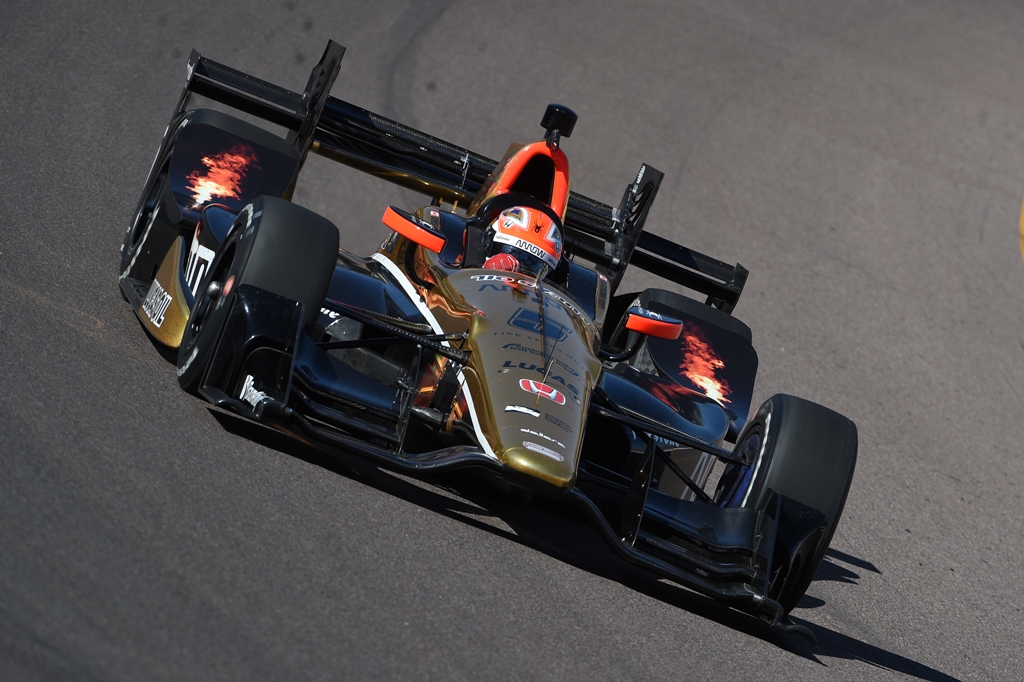
Photo Credit: Chris Jones/IndyCar
For the first time since his crash at Indianapolis Motor Speedway that left him seriously injured, James Hinchcliffe hit the track with his peers as part of the Verizon IndyCar Series test at Phoenix International Raceway. While he had done some previous private testing thus far during the off-season, it was the first open session for Schmidt Peterson Motorsports driver.
“It feels like the first day in school,” he said. “We traveled to some races in the second half of the year. I still felt like a little bit of an outsider because I wasn’t doing my job. To now be back here and be back in the car with everybody, it’s great to see all those familiar faces again.
“I’ve been driving the car. Obviously testing and driving IndyCar is phenomenal always, but it’s competition that you really miss after a while. It’s nice to be back here with a bunch of cars on track and get sort of those competitive juices flowing again.”
On May 18, Hinchcliffe was injured when his IndyCar made right-side contact with the Turn 2 SAFER Barrier during practice for the Indianapolis 500. He was transported by ground to IU Health Methodist Hospital, where he underwent upper left thigh and pelvic surgery the same day. He spent some time in the Intensive Care Unit, before being released from hospital on May 26. The injuries caused Hinchcliffe to miss the remainder of the season.
He was able to attend some races, watching the events from the pit box with his team as Ryan Briscoe piloted the car. He joked one of the things that he noticed was how chaotic the timing stands are.
“I thought engineers knew what they were doing, but apparently not. This is a very fly-by-the-seat-of-your-pants business we’re in. It was very fascinating to sit on pit wall and see how these races unfolded, how decisions were made,” he said. “When you’re in the car, you get one voice telling you one thing. You just kind of take it as gospel and go from there. For me it was fascinating to see how some of these decisions were made. Sometimes when they come on and tell you something, your thinking, Are you crazy? Why are we doing this?
“But now I understand it a whole lot better. I understand how races unfold from a timing standpoint better. I think that’s going to make communication between me and the pit stand during races a lot easier. It will certainly give me a little more comfort and confidence that they really do know what they’re doing even though it looks like kindergarten class down there.”
Now back behind the wheel of his familiar No. 5 Arrow Dallara chassis powered by Honda, he’s hoping to run all of the events this season, including the series’ first trip back to Phoenix Raceway since 2005.
“The track is a whole lot of fun,” he commented. “This is a tough little place. It’s incredible how little time you have to think about anything around a lap here. It’s so flat out, you cannot let your concentration waiver for even a fraction of a second. The back straight is not a straight. The front straight is the only chance you have, whether it’s to adjust your weight jack, your roll bars, whatever it is. You have about three and a half, four seconds to get it done over a lap. That’s exhausting.”
While he hasn’t been on the track, he had watched races of the past, and feels that returning to the oval is a huge step for the series moving forward, simply based on what he calls incredible feedback from the fans thus far.
“On social media, we’ve had a lot of feedback from people,” he commented. “The track president said today he’s expecting between 5,000 and 10,000 fans to show up for the test tomorrow. I think that speaks volumes for this city and how anxious they are to have IndyCar back. Certainly everybody in the Verizon IndyCar Series is happy to be coming back and bring another iconic venue back on the calendar.”
Only six of the current drivers have visited Phoenix in the past, so the day left many drivers wondering what they could compare the track to. Some said it reminded them a bit of Iowa Speedway, another short oval the series visits, whereas Hinchcliffe says it has a bit of Iowa, Milwaukee Speedway and Pocono Raceway combined into one.
“One and two is a lot like Iowa three and four. Three and four is a lot like Milwaukee one and two. You have the dogleg in the back straight, which is kind of like turn two at Pocono,” he said. “It makes setting the car up very difficult. It’s a huge challenge for the engineers. It’s going to be a huge challenge for the drivers in the race, as well.”




